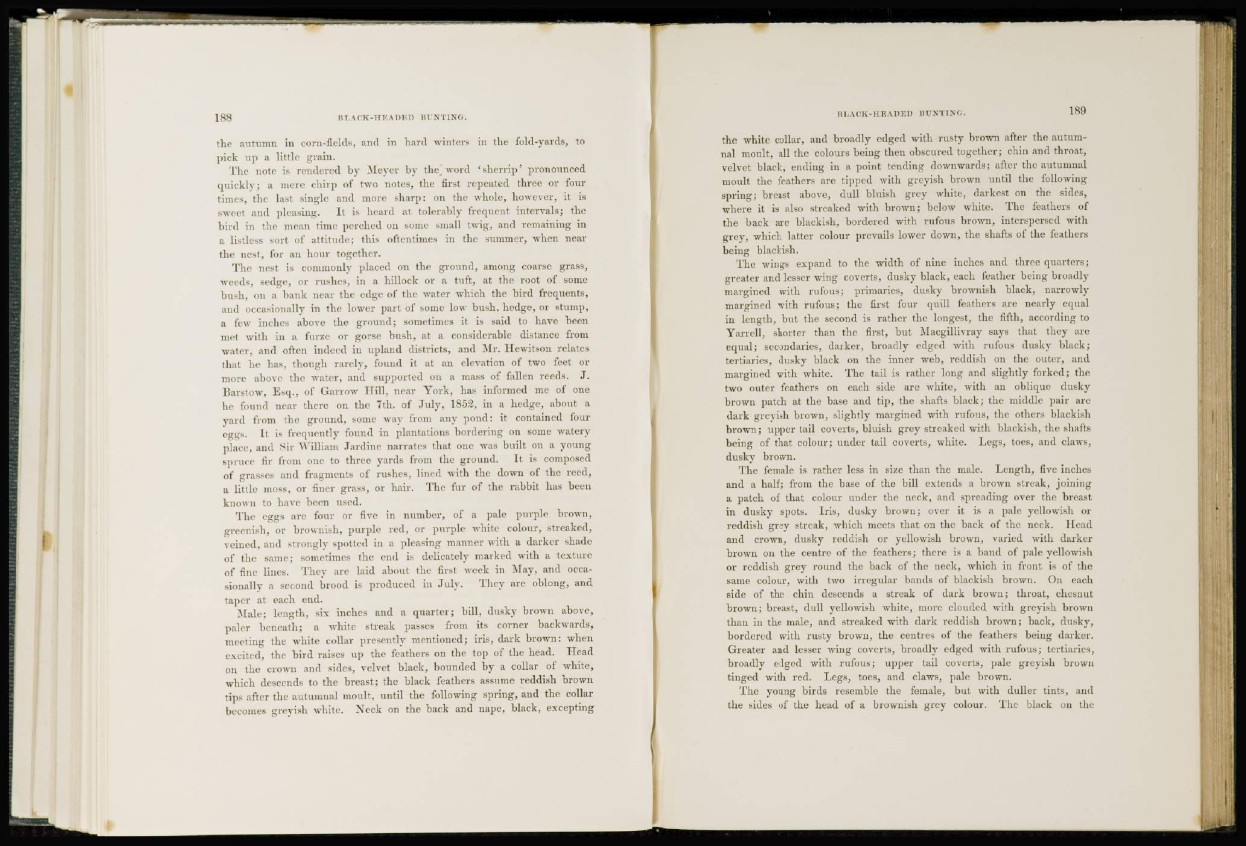
L88 B L I C K - H E A D E D B U N T I NG
the autumn in corn-fields, and in hard winters in the fold-yards, to
pick up a little grain.
The note is rendered by Meyer by the. word ' sherrip' pronounced
<|ui( kl\ : a mere chirp of two notes, the first repeated three or four
times, the last single and more sharp: on the whole, however, it is
sweet and pleasing. It is heard at tolerably frequent intervals; the
bird in the mean time perched on some small twig, and remaining in
a listless sort of attitude; this oftentimes in the summer, when near
the nest, for an hour together.
The nest is commonly placed on the ground, among coarse grass,
weeds, sedge, or rushes, in a hillock or a tuft, at the root of some
bush, on a bank near the edge of the water which the bird freqttents,
and occasionally in the lower part of some low bush, hedge, or stump,
a few inches above the ground; sometimes it is said to have been
met with in a furze or gorse hush, at a considerable distance from
water, and often indeed in upland districts, and Mr. Hcwitsou relates
that In- has, though rarely, found It at an elevation of two feet or
more above the water, and supported on a mass of fallen reeds. J.
Rarstow, Esq., of Garrow Hill, near York, has informed me of one
he found near there on the Tth. of July, 1852, in a hedge, about a
yard from the ground, some way from any pond: it contained four
eggs. It is frequently found in plantations bordering on some watcrv
place, and Sir William Jardine narrates that one was built on a young
spruce fir from one to three yards from the ground. It is composed
of grasses and fragments of rushes, lined with the down of the reed,
a little moss, or finer grass, or hair. The fur of the rabbit has been
known to have been used.
The eggs arc four or five in number, of a pale purple brown,
greenish, or brownish, purple red, or purple white colour, streaked,
veined, and strongly spotted in a pleasing manner with a darker shade
of the same; sometimes the end is delicately marked with a texture
of fine lines. They are laid about the first week in May, and occasionally
a second brood is produced in July. They are oblong, and
taper at each end.
Male; length, six inches and a quarter; bill, dusky brown above,
paler beneath; a white streak passes from its corner backwards,
meeting the white collar presently mentioned; iris, dark brown: when
excited, the bird raises up the feathers on the top of the head. Head
on the crown and sides, velvet black, bounded by a collar of white,
which descends to the breast; the black feathers assume reddish brown
tips after the autumnal moult, until the following spring, and the collar
becomes greyish white. Neck on the back and nape, black, excepting
B L A C K - H E A D E D BUNTING. 189
the white collar, and broadly edged with rusty brown after the autumnal
moult, all the colours being then obscured together; chin and throat,
velvet black, ending in a point tending downwards; after the autumnal
moult the feathers are tipped with greyish brown until the following
spring; breast above, dull bluish grey white, darkest on the sides,
where it is also streaked with brown; below white. The feathers of
the back are blackish, bordered with rufous brown, interspersed with
grey, which latter colour prevails lower down, the shafts of the feathers
being blackish.
The wings expand to the width of nine inches and three quarters;
greater and lesser wing coverts, dusky black, each feather being broadly
margined with rufous; primaries, dusky brownish black, narrowly
margined with rufous; the first four quill feathers are nearly equal
in length, but the second is rather the longest, the fifth, according to
Yarrell, shorter than the first, but Macgillivray says that they arc
equal; secondaries, darker, broadly edged with rufous dusky black;
tertiaries, dusky black on the inner web, reddish on the outer, and
margined with white. The tail is rather long and slightly forked; the
two outer feathers on each side are white, with an oblique dusky
brown patch at the base and tip, the shafts black; the middle pair are
dark greyish brown, slightly margined with rufous, the others blackish
brown; upper tail coverts, bluish grey streaked with blackish, the shafts
being of that colour; under tail coverts, white. Legs, toes, and claws,
dusky brown.
The female is rather less in size than the male. Length, five inches
and a half; from the base of the bill extends a brown streak, joining
a patch of that colour under the neck, and spreading over the breast
in dusky spots. Iris, dusky brown; over it is a pale yellowish or
reddish grey streak, which meets that on the back of the neck. Head
and crown, dusky reddish or yellowish brown, varied with darker
brown on the centre of the feathers; there is a band of pale yellowish
or reddish grey round the back of the neck, which in front is of the
same colour, with two irregular bands of blackish brown. On each
side of the chin descends a streak of dark brown; throat, chesnut
brown; breast, dull yellowish white, more clouded with greyish brown
than in the male, and streaked with dark reddish brown; back, dusky,
bordered with rusty brown, the centres of the feathers being darker.
Greater and lesser wing coverts, broadly edged with rufous; tertiaries,
broadly edged with rufous; upper tail coverts, pale greyish brown
tinged with red. Legs, toes, and claws, pale brown.
The young birds resemble the female, but with duller tints, and
the sides of the head of a brownish grey colour. The black on the